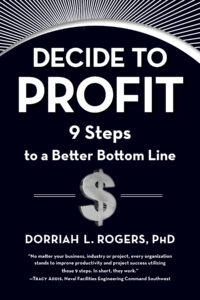How to Improve Your Bottom Line
In the last several years, businesses have faced smarter competitors, continual change, technological innovations, and uncertainty.
It seems more difficult than ever to both grow the top line of a business and the bottom line, too.
That’s the challenge that Dr. Dorriah Rogers, CEO of Paradyne Consulting Works, takes on.
From her work with some of the most complex projects and organizations, Dorriah has developed a 9 step program to grow net profit. After reading her new book Decide to Profit: 9 Steps to a Better Bottom Line, I asked her to share more about her research and experience.
Tell us more about the 9 steps and how you arrived at them.
The 9 steps are the result of many years of implementing various profit-focused solutions and systems across many different types of industries and companies. At one point in my consulting career, a senior executive (almost, but not quite) jokingly asked me if I could develop an “Operations Manual” of all the tools I had at my disposal. That was the genesis of the 9 Steps. From there, I kept refining the steps, making sure they were interrelated, and asked for real-world feedback from my clients, until I had it down to a system as simple as I could make it. I wanted to create a process that was not overly complicated to understand or use, and I wanted to create something that both managers making decisions and employees wanting to make an impact could readily implement to help their companies improve profitability.
Identifying the system that needs improvement seems straightforward, but it isn’t as easy as it sounds. What if you can’t seem to identify which one is off course?
Agreed. It is not simple to get started. And that is why so many of my clients struggled. They either focused on too many improvements or the wrong ones. In many cases, most managers and employees inherently know where they need to start, or in what general area, and that is as good a point to begin with as any. It may not be as tight a starting point as you might want, but the 9 Steps will help to define and clarify if it is the right place to focus your attention and resources as you progress. Keep in mind that a “system improvement” could be as big as an entire corporate overhaul (like the Lego case study in the book) or as small as an internal vendor payment process. The idea is to find those things that are impacting your ability to make money. So the first place to start is to discuss internally which things are impacting your ability to generate profit. Not revenue, but profit.
Companies have a choice: keep doing what you’re doing and make incremental (or no) improvements to your bottom line, or tackle your best estimate of the system within your organization that could potentially have the biggest impact on profit. You might start out with the wrong one, but the beauty of the 9 Steps is the iterative process built into it. Along the way (and fairly soon) you will realize that the system you chose to improve might not be the right one because it is NOT positively impacting your financial goals, and the steps will prove that out for you through the ROI process. At that point, you simply readjust, and the 9 Steps will guide you closer to those areas that will have the biggest impact. So in short, start somewhere and the 9 Steps process will get you where you need to be.
Beware the Expert Loop
What is the expert loop and how does it often cause problems?
The expert loop was first coined by Alex “Sandy” Pentland in his November 2013 HBR article entitled “Beyond the Echo Chamber.” In it, he posited that within organizations only a handful or individuals are viewed as the experts and the only ones who are capable of making important decisions. I agree with his conclusions that, in fact, seeking information outside of this expert network is often much more valuable. Time and time again I have seen the phenomenon of top executives sitting in rooms with the same small group of people as they rehash both problems and ideas in a tired, circular rhythm. The same ideas are beaten to death, and the same people are heard. Even when new people are brought into the conversation, their ideas are often dismissed or even scoffed at as the experts re-establish their positions of authority at the top of the food chain. The problem this creates is twofold: a lack of true innovation and the stifling of a culture of continuous improvement. While it is true that experts should (and do) have great ideas, it often requires a fresh perspective or a dissenting voice to shake things up and move the company in a new direction. Some of the best ideas I have ever heard have come from the most unexpected voices.
9 Steps to Improving Your Bottom Line
- Identify the system that needs improvement.
- Put the right team together.
- Identify the goal.
- Observe the system.
- Identify bottlenecks within the system.
- Brainstorm.
- Select optimal solutions for improvement.
- Implement one change at a time.
- Sustain a culture of continuous improvement.
Unlock the Power of Brainstorming
Brainstorm is Step 6 while many would think you would start there. Why is it here? How can brainstorming go wrong? What do you look for in a team that is doing it right?
Brainstorming is a key element of the 9 Steps process. It is virtually impossible in today’s economy for organizations to grow without innovation—finding new concepts and new ideas. Most business professionals and many management thought leaders agree that innovation is critical to success. Recent studies reveal that more than ninety percent of executives believe that long-term success is directly linked to the organization’s ability to develop new ideas. Despite this awareness at the top, many employees feel that their company is simply not doing enough to nurture this way of thinking. And the problem is that neither knows how. Executives and managers understand the need, and employees want to contribute, but neither knows how to do so in a systematic, results-driven manner.
So why is brainstorming Step 6 of the 9 steps and why not up front? Because creativity and innovation needs to occur with focus. And that focus needs to be on solving an observed, singular and goal-driven problem, as opposed to identifying a myriad of problems and solutions that may or may not be related to profitability. The first five steps in the 9 Steps drives the team to the point of understanding exactly what it is that they need to solve, and Step 6 provides guidelines on how to brainstorm effectively to solve it.
There are two killers of effective brainstorming sessions: bias and groupthink. Bias is the desire to stick to the status quo, and it is driven primarily by fear. Although this type of fear of change can often be unfounded, psychological research indicates that this type of bias is a “go to” reflex that many humans display. This knee-jerk reaction is not at all conducive to innovation or the brainstorming process. It can also explain why even though good ideas can be generated, it is often difficult to actually implement them. This becomes especially difficult the more radical (and often riskier) the idea. The higher the risk, the easier it is for the supervisor to say no. If your organization displays this type of status quo bias, it may be difficult to foster creativity and promote brainstorming. It will also become difficult to create a culture of continuous change or improvement the more “stuck” your organizational culture is.
Groupthink is the second deadliest enemy of brainstorming. Groupthink is defined as achieving consensus while minimizing conflict. In a groupthink environment, conflict avoidance is the primary goal over achieving any breakthrough in thought. Groupthink can be an end-result of status quo bias, or it can be a reflection of heavy-handed management. Either way, groupthink suppresses innovation and individual thought. Organizations that exhibit groupthink culture often miss market shifts or miss out on new technologies. Organizations with strong process history also tend to groupthink internal processes, as straying from these paths can be viewed as perilous to ongoing operations. Instead, companies continue to use outdated or inefficient processes (or systems) simply because the dread of changing to something new outweighs the perceived value of anything new.
The process of ideation, however, does not come naturally to most of us. Our experience teaches us, from a very young age, that there are right ways to do things and wrong ways to do things, that there are right answers and wrong answers, and even that there are stupid questions . . . despite what your peers or superiors tell you. Is there any wonder then that most of us are ill-prepared to participate in a no-holds-barred, positive interchange of ideas in which you are encouraged to dream and play “I wish for” games? Teams that do brainstorming right exhibit high energy, no ideas are considered stupid, team members contribute equally no matter their position, experience or discipline, and meetings are attended with an infectious eagerness.
Is there one step that more leaders get stuck on than others?
 Absolutely. And that is Step 4: Observe the System. Most organizations and executives I know want to skip this step because they already know the outcome. They find this step to be arduous, tedious and time consuming. Step 4 requires rigorous discipline and objective analysis, both of which are difficult in today’s fast-paced corporate environment. The purpose of Step 4 is to objectively, and with an unbiased eye, observe the system that needs fixing. Step 4 is included in the 9 Steps for a couple of reasons. First, to confirm that the system you are seeking to improve is indeed an unproductive system or process and, second, to remove any filtering or organizational bias. It is designed to be an entirely empirical step, completely quantitative and based on data, not based on personal or subjective judgment. In my experience, anything that requires this type of discipline can be difficult. Most of the false starts I experienced in the development of the 9 Steps happened here. For whatever reason, we had to continuously go back to Step 4 to remove any bias or preconceived ideas of outcomes.
Absolutely. And that is Step 4: Observe the System. Most organizations and executives I know want to skip this step because they already know the outcome. They find this step to be arduous, tedious and time consuming. Step 4 requires rigorous discipline and objective analysis, both of which are difficult in today’s fast-paced corporate environment. The purpose of Step 4 is to objectively, and with an unbiased eye, observe the system that needs fixing. Step 4 is included in the 9 Steps for a couple of reasons. First, to confirm that the system you are seeking to improve is indeed an unproductive system or process and, second, to remove any filtering or organizational bias. It is designed to be an entirely empirical step, completely quantitative and based on data, not based on personal or subjective judgment. In my experience, anything that requires this type of discipline can be difficult. Most of the false starts I experienced in the development of the 9 Steps happened here. For whatever reason, we had to continuously go back to Step 4 to remove any bias or preconceived ideas of outcomes.
In fact, I highly recommend hiring people who are good at this unbiased observation to objectively observe and provide recommendations, especially if your systems are complex. The tools listed in the book are meant as a guideline. From the simplest like the fishbone diagram to the most complex like the Kaizen, sometimes it is best to use people outside of your organization who are skilled at these analyses. This is likely the most difficult and complex portion of the 9 Steps process – and typically where most organizations fail. They are either unwilling or unable to allocate the time and resources to this effort. I must admit I spent an inordinate amount of time simply convincing organizations of the need to perform this analysis. Most companies prefer to rely on their own internal information and overly simple or anecdotal observations. Many assume that their approach will suffice. If it did, then they are already making the maximum amount of money that they possibly could and do not need the 9 Steps.
Develop a Culture of Continuous Improvement
How do you develop a culture that continues growth?
I promote a culture of continuous “improvement” as opposed to a culture of continuous “growth.” And there is a reason for that distinction. In my experience, many companies view “growth” as increased top-line revenue or sales, additional product lines, or entry into new markets. Growth is typically more of a step event, as opposed to improvement, which is embedded and incremental. In my opinion, none of these are the true indicators of success. If you can do all of these things AND increase profit? Well, now we’re talking. So in order to develop a culture of continuous improvement, there are two primary areas of focus: behavioral changes and process changes. For behavioral changes, I recommend the following:
- Acknowledge the difficulties. Cultural change is difficult as it forces established habits, hierarchies, processes and people to think and behave in unfamiliar ways. The knowledge that these difficulties exist is the first step to overcome them.
- Overcome the difficulties. Overcoming hurdles to organizational change requires a unified effort and message from management, as well as the identification, empowerment and support of several key change agents.
- Make it stick. Ensuring the sustainability of cultural change requires the ongoing measurement and assessment of your business performance, behaviors and employee attitudes.
As for the second area of focus, process, I recommend implementation of the 9 Steps. In order for the 9 Steps to work effectively, the culture of the organization implementing them must reflect an ongoing and continuous curiosity. Complacency and surrender can kill this curiosity, and creating this type of culture can be extremely difficult, especially if historically your people and processes are imbedded. With Steps 1-8, a process is imbedded that allows alignment between employees and management that is focused on the right decisions for the right reasons: to ultimately make money. Step 9 is designed to ensure that your people and your ways of thinking are always asking questions, always challenging yourselves, never accepting the as-is, and ensuring that whether you fail or succeed at change or innovation does not quell the desire to constantly come up with new and better solutions. And Step 9 has a built-in feedback loop that continuously brings you back to Step 1 and so on. So between behaviors and a simple process, that is how you continuously grow and improve your organization.
What words describe a leadership culture that is on track, truly deciding to profit?
Open, curious, democratic, focused, productive, efficient.
For more information, see Decide to Profit: 9 Steps to a Better Bottom Line.
Let us help you innovate YOU! By signing up for FREE to Leadership Insights, you will have a positive stream of insights to reimagine your future! Plus get Skip’s free leadership book and digital seminar on creativity.subscribe]

